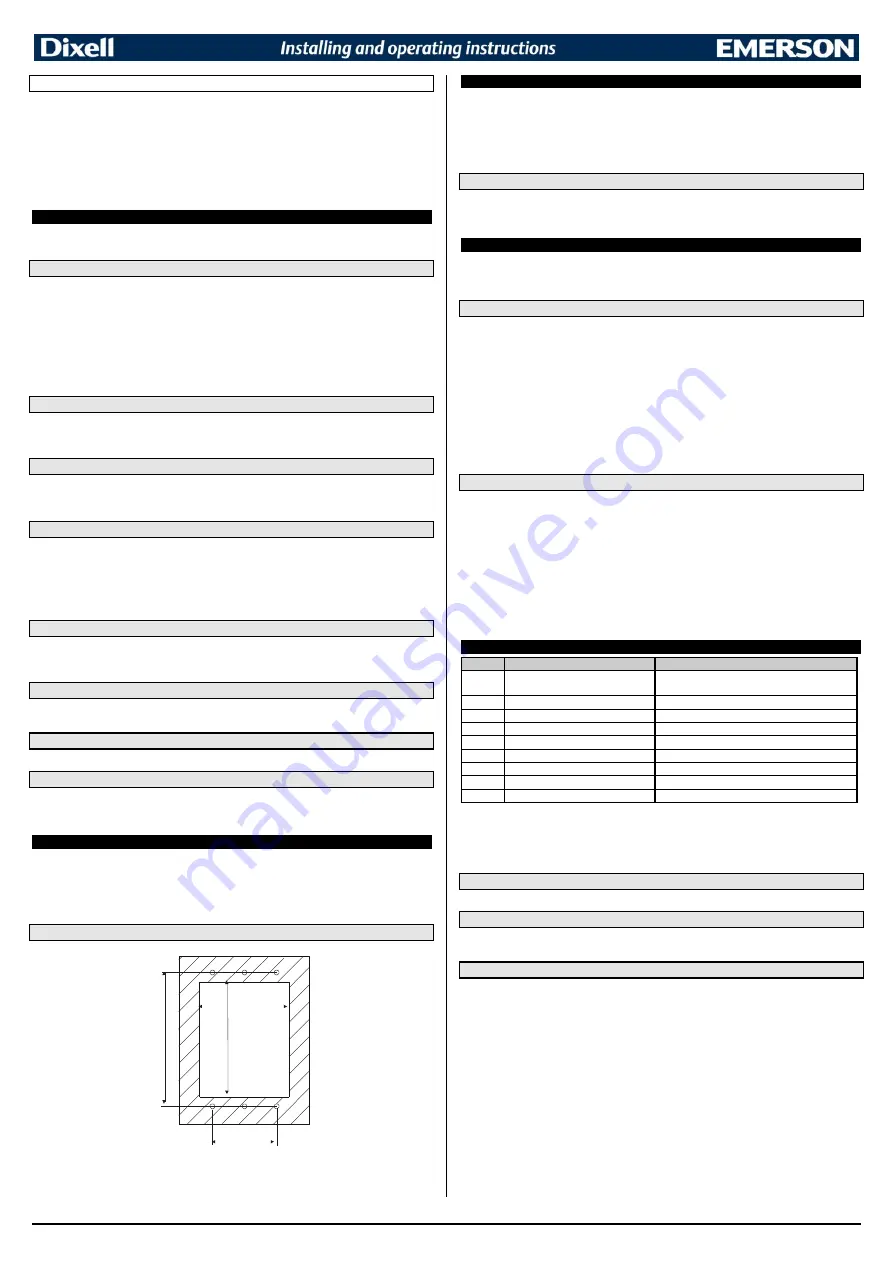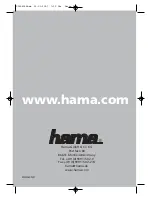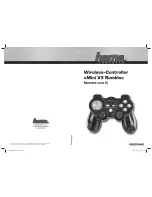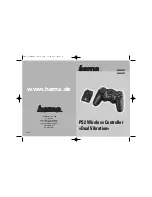
1592009730 XW30-35VS GB r1.2 31.07.2015
XW30VS - XW35VS
3/4
OTHER
Adr RS485 serial address
(1÷247)
:
Identifies the instrument address when connected to a ModBUS
compatible monitoring system.
PbC Type of probe:
it allows to set the kind of probe used by the instrument:
PbC
= PBC probe,
ntC =
NTC probe.
rEL Release software:
(read only) Software version of the microprocessor.
Ptb Parameter table:
(read only) it shows the original code of the Dixell parameter map.
Prd Probes display:
(read only) display the temperature.
Pr2 Access to the protected parameter list
(read only).
6.
DIGITAL INPUT
The controllers have 1 free contact digital input. It is programmable in seven different configurations by
the “
I2F
” parameter.
6.1
DOOR SWITCH INPUT (I2F = dor)
It signals the door status and the corresponding relay output status through the “
odc
” parameter:
no
= normal (any change);
Fan
= Fan OFF;
CPr
= Compressor OFF;
F_C
= Compressor and fan OFF.
Since the door is opened, after the delay time set through parameter “
dOA
”, the alarm output is
enabled and the display shows the message “
dA
”. The alarm stops as soon as the external digital input
is disabled again. During this time and then for the delay “
dot
” after closing the door, the high and low
temperature alarms are disabled.
6.2
GENERIC ALARM (I2F = EAL)
As soon as the digital input is activated the unit will wait for “
did
” time delay before signalling the “
EAL
”
alarm message. The outputs status don’t change. The alarm stops just after the digital input is de-
activated.
6.3
SERIOUS ALARM MODE (I2F = BAL)
When the digital input is activated, the unit will wait for “
did
” delay before signalling the “
BAL
” alarm
message. The relay outputs are switched OFF. The alarm will stop as soon as the digital input is de-
activated.
6.4
PRESSURE SWITCH (I2F = PAL)
If during the interval time set by “
did
” parameter, the pressure switch has reached the number of
activation of the “
nPS
” parameter, the “
PAL
” pressure alarm message will be displayed. The
compressor and the regulation are stopped. When the digital input is ON the compressor is always
OFF.
If the nPS activation in the did time is reached, switch off and on the instrument to restart
normal regulation.
6.5
START DEFROST (I2F = DFR)
It executes a defrost if there are the right conditions. After the defrost is finished, the normal regulation
will restart only if the digital input is disabled otherwise the instrument will wait until the “Mdf” safety time
is expired.
6.6
ENERGY SAVING (I2F = ES)
The Energy Saving function allows to change the set point value as the result of the SET+ HES
(parmeter) sum. This function is enabled until the digital input is activated.
6.7
REMOTE ON/OFF (I2F = ONF)
This function allows to switch ON and OFF the instrument.
6.8
DIGITAL INPUTS POLARITY
The digital input polarity depends on the “
I2P
” parameters.
CL
: the digital input is activated by closing the contact.
OP
: the digital input is activated by opening the contact
7.
INSTALLATION AND MOUNTING
Instruments shall be mounted on vertical panel, in a 72x56 mm hole, and fixed using screws
3 x
2mm. To obtain an IP65 protection grade use the front panel rubber gasket (mod. RGW-V).
The temperature range allowed for correct operation is 0 - 60 °C. Avoid places subject to strong
vibrations, corrosive gases, excessive dirt or humidity. The same recommendations apply to probes.
Let the air circulate by the cooling holes.
7.1
CUT OUT
56
72
40
83
,5
8.
ELECTRICAL CONNECTIONS
Relays, power supply, digital and analogue inputs have a Faston connection (6,3mm). Heat-resistant
cables have to be used. Before connecting cables make sure the power supply complies with the
instrument’s requirements. Separate the probe cables from the power supply cables, from the outputs
and the power connections. Do not exceed the maximum current allowed on each relay, in case of
heavier loads use a suitable external relay.
N.B.
Maximum current allowed for all the loads is 20A.
8.1
PROBE CONNECTIONS
The probe shall be mounted with the bulb upwards to prevent damages due to casual liquid infiltration.
It is recommended to place the thermostat probe away from air streams to correctly measure the
average room temperature.
9.
USE OF THE PROGRAMMING “HOT KEY “
The Wing units can UPLOAD or DOWNLOAD the parameter list from its own E2 internal memory to the
“Hot Key”
and vice-versa.
9.1
DOWNLOAD (FROM THE “HOT KEY” TO THE INSTRUMENT)
1.
Turn OFF the instrument by means of the ON/OFF key, remove the TTL serial cable if present,
insert the
“Hot Key”
and then turn the Wing ON.
2.
Automatically the parameter list of the
“Hot Key”
is downloaded into the Wing memory, the
“
DoL
” message is blinking. After 10 seconds the instrument will restart working with the new
parameters.
3.
Turn OFF the instrument remove the
“Hot Key”,
plug in the TTL serial cable, then turn it ON
again.
At the end of the data transfer phase the instrument displays the following messages:
“
end
“ for right programming. The instrument starts regularly with the new programming.
“
err
” for failed programming. In this case turn the unit off and then on if you want to restart the
download again or remove the “
Hot key
” to abort the operation.
9.2
UPLOAD (FROM THE INSTRUMENT TO THE “HOT KEY”)
1.
Turn OFF the instrument by means of the ON/OFF key and remove the TTL serial cable if
present; then turn it ON again.
2.
When the Wing unit is ON, insert the “
Hot key
” and push
o
key; the
"uPL"
message
appears.
3.
Push “
SET”
key to start the UPLOAD; the “
uPL
” message is blinking.
4.
Turn OFF the instrument remove the
“Hot Key”,
plug in the TTL serial cable, then turn it ON
again.
At the end of the data transfer phase the instrument displays the following messages:
“
end
“ for right programming.
“
err
” for failed programming. In this case push “SET” key if you want to restart the programming again
or remove the not programmed “
Hot key
”.
10.
ALARM SIGNALS
Message Cause
Outputs
“P1”
Thermostat probe failure
Alarm output ON; Compressor output according to
parameters “COn” and “COF”
“P3”
Display probe failure
Alarm output ON; Other outputs unchanged
“HA”
Maximum temperature alarm
Alarm output ON; Other outputs unchanged
“LA”
Minimum temperature alarm
Alarm output ON; Other outputs unchanged
“EE” Data or memory failure
Alarm output ON; Other outputs unchanged
“dA”
Door switch alarm
Alarm output ON; Other outputs unchanged
“EAL” External alarm
Alarm output ON; Other outputs unchanged
“bAL” Serious external alarm
Alarm output ON; Other outputs OFF
“PAL” Pressure switch alarm
Alarm output ON; Other outputs OFF
The alarm message is displayed until the alarm condition is recovery.
All the alarm messages are showed alternating with the room temperature except for the “P1” which is
flashing. To reset the “EE” alarm and restart the normal functioning press any key, the “
rSt
” message is
displayed for about 3s.
10.1
SILENCING BUZZER
Once the alarm signal is detected the buzzer can be silenced by pressing any key.
10.2
“EE” ALARM
The Dixell instruments are provided with an internal check for the data integrity. Alarm “EE” flashes
when a failure in the memory data occurs. In such cases the alarm output is enabled.
10.3
ALARM RECOVERY
Probe alarms
: “
P1
” (probe1 faulty) and
“P3”
; they automatically stop 10s after the probe restarts
normal operation. Check connections before replacing the probe.
Temperature alarms
“
HA
” and “
LA
” automatically stop as soon as the thermostat temperature returns
to normal values or when the defrost starts.
Door switch alarm
“
dA
” stop as soon as the door is closed.
External alarms
“
EAL
”, “
BAL
” stop as soon as the external digital input is disabled
Pressure switch alarm
“
PAL” alarm is recovered by switching OFF the instrument
.





















